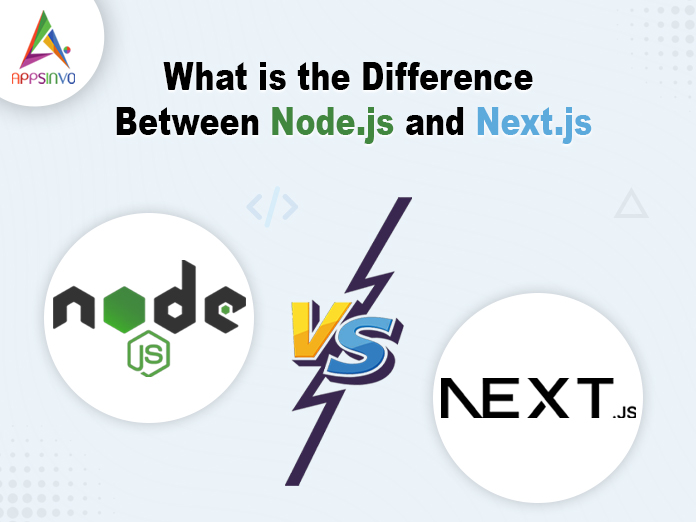In the world of web development, both Node.js and Next.js have grown in popularity, with each offering a unique purpose and functionality. Knowing these distinctions is critical for developers who want to construct efficient and scalable apps.
What is Node.js?
Node.js is a runtime environment that enables developers to run JavaScript applications on the server.
Node.js, built on Microsoft Chrome’s V8 JavaScript engine, allows you to create fast and scalable network applications. Here are some of the important aspects of Node.js
1. Asynchronous and event-driven
Node.js has a non-blocking, event-driven architecture, making it ideal for developing apps that manage several connections at onetime. This is especially useful for I/O-intensive processes, such as web servers.
2. Single Programming Language
Node.js allows developers to utilize JavaScript for both client-side and server-side development, simplifying the building process and enabling full-stack JavaScript applications.
3. Rich ecosystem
Node.js has a large ecosystem of modules and frameworks available via npm (Node Package Manager), allowing developers to easily integrate different functionalities into their applications.
4. Microservices and APIs
Node.js is widely used for developing RESTful APIs and microservices, making it an attractive option for backend development.
What is Next.js?
Next.js is a React framework allowing developers to quickly develop server-rendered React applications. It extends React’s capabilities by including built-in features that boost performance and user experience. Next.js has several key features, including:
1. Server Side Rendering (SSR)
Unlike standard applications with one page (SPAs), Next.js offers server-side rendering, which means pages can be produced on the server before being transmitted to the client. This results in speedier initial load times and better SEO.
2. Static site generation (SSG)
Next.js makes it easier to create static websites by allowing developers to pre-render pages during the build process. This improves performance and can drastically reduce server load.
3. API routes
Next.js allows developers to construct API endpoints directly within the application, making data fetching and server-side functionality smoother.
4. Automatic Code Splitting
Next.js automatically divides code, ensuring that only the essential JavaScript is loaded for each page, resulting in improved speed and faster load times.
5. File-based Routing
Next.js streamlines routing by utilizing a file-based approach, which makes it simple to design routes based on file structure.
Key Differences
1. Purpose
Node.js: Its primary function is to provide a runtime environment for server-side JavaScript execution. It is not a framework, but it may be used for building a wide range of applications, including APIs, web servers, and more.
Next.js: A framework developed exclusively for developing React apps, including advanced features such as SSR and SSG. It focuses on improving the programming experience for React developers.
2. Rendering
Node.js: Typically used for server-side processing; does not provide built-in support for rendering React elements or managing front-end interactions.
Next.js: It has integrated support for rendering on the server and stationary site generation, making it perfect for applications that demand high performance and SEO.
3. Routing
Node.js: Routing and managing HTTP requests need the use of other libraries (such as Express.js).
Next.js: Features an easy-to-use file-based routing system for route development and administration.
4. Deployment
Node.js: Applications can be distributed across several platforms, however the deployment process may necessitate additional configuration and setup. Next.js: Typically deployed as serverless functions or static sites, particularly when employing technologies such as Vercel, the company behind Next.js.
5. Ecosystem
Node.js: Provides a broad ecosystem of modules and tools via npm, catering to a wide range of applications outside web development.
Next.js: Built on top of React, it takes advantage of the React ecosystem while adding a unique collection of tools and features to improve efficiency and usability.
When to Use Which?
Use Node.js: When developing backend services, RESTful APIs, real-time apps, or microservices. It is best suited for applications that require significant concurrency and performance.
Use next.js: When creating a front-end application that uses server-side rendering, static site generation, or requires seamless integration with React. It is ideal for e-commerce websites, blogs, and apps that require high SEO and functionality.
Conclusion
In summary, Node.js and Next.js perform distinct but complimentary roles in web development. Node.js is a sophisticated runtime environment for server-side JavaScript, whereas Next.js provides advanced rendering abilities to React apps. Understanding these distinctions enables developers to select the best solution for their particular project needs, resulting in more efficient and effective online applications.













[…] post What is the Difference Between Node.js and Next.js? appeared first on Appsinvo […]
Excellent beat ! I wish to apprentice while you amend your website,
how could i subscribe for a blog site? The account aided
me a acceptable deal. I had been a little bit acquainted of this
your broadcast provided bright clear concept
Welcome to HackersList!
Need secure and discreet digital solutions? Our platform connects you with verified hackers for tasks such as account recovery and secure data access. We ensure encrypted communication, anonymous service handling, and fast results. Trust our experts to solve your digital challenges while prioritizing your privacy and security.
https://hackerslist.com/search-task/
Thank you for choosing HackersList!